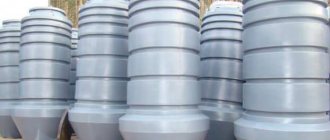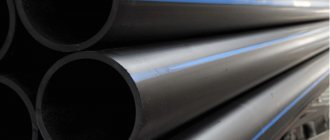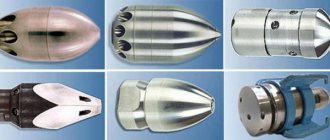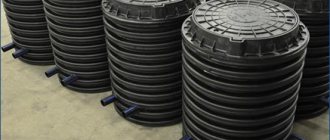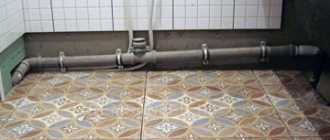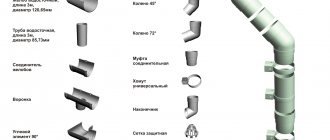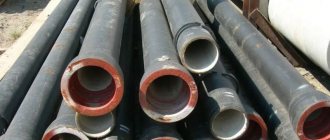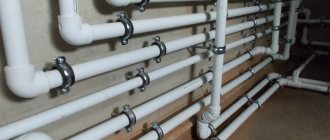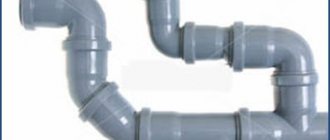To install sewerage in a private house, special pipes and fittings must be used.
Without them, it is impossible to connect pipes. These shaped parts are made from a variety of materials, which affect their service life and sales value. Modern polymers are considered the most popular material for the production of pipes, adapters and fittings. Such products are much more convenient to use than installing their cast iron counterparts. Moreover, all the main parameters of such parts are exactly the same as those of steel elements.
Polymer pipes, as well as additional fittings, are made from several materials:
- Polypropylene - PP,
- Polyvinyl chloride - PVC.
To make a pipe connection, special adapters are used. They are very easy to maintain and install.
Why do you need an adapter?
Such parts belong to pipeline fittings, without which it is impossible to connect parts of different diameters. Moreover, such adapters are capable of connecting parts made of different materials.
Note that adapters are used when installing any type of sewer system; they remain the most indispensable part.
Today, a variety of materials are used to make them. They may differ in shape and size. Basically, the following popular materials are used for manufacturing:
- PVC;
- Polypropylene;
- Cast iron;
- Steel.
The design of adapters has several types:
- Concentric. Used only when installing a vertical line;
- Eccentric. Parts are used only when the pipes are horizontal.
Classification
In addition to classification by purpose, fittings can differ in many other ways. First of all, this is the material from which both pipes and fittings for them are made. All the advantages of plastic have already been discussed above. But for one reason or another, Russian residents do not always prefer pipelines made of PVC materials. In our country, metal structures enjoy the greatest confidence.
Cast iron is the most traditional of materials, but has many disadvantages. One of the advantages is the longest service life - about 80 years. Most cast iron sewer systems in Russia have existed since Soviet times. Over the years, numerous growths have formed on the inner walls of such pipes, making it difficult for water to pass through. When replacing them, the same material is rarely used. The reason for this is the significant disadvantages of cast iron: it has a high cost and heavy weight, which complicates installation. Cast iron fittings are rarely used for domestic purposes for the same reasons.
There are alternative options, which also have their drawbacks, which is why they are used less and less in construction. For example, copper is the most expensive of materials. Very resistant to corrosion and alkaline environments. Copper pipes are not used for laying water pipes due to their ability to change the smell and color of water. And for sewerage, you can find cheaper materials. Another alternative is stainless steel, which, on the contrary, is vulnerable to corrosion.
Non-metallic materials include asbestos cement and ceramics. The first option is practically free of the disadvantages that metal pipes suffer from. Asbestos cement systems do not suffer from corrosion, are lightweight and last a long time. But this material is quite fragile and can be easily damaged during installation. Ceramics is the closest option to an ideal material, as it has a long range of advantages. In addition, ceramic systems boast a variety of fittings available. But most of these advantages are negated by one disadvantage - the price is too high.
Due to various disadvantages of the listed materials, PVC pipes, compared to other analogues, look like the most profitable and practical solution. Fittings also differ in size. When choosing them, you should take into account the parameters of the pipes that need to be connected. Their weight and length, for example, do not matter. The main indicators in this case are the internal and external diameters of the pipes. They can vary from 25 to 110 mm or more.
Basic properties of adapters
When laying sewer pipes yourself, PVC adapters are always installed. They make it possible to create any, even the most complex, pipeline configuration, as well as connect the necessary plumbing devices to it.
Thanks to sewer adapters, several technological operations can be carried out:
- Change the direction of the pipeline;
- Change to another size;
- Dispose of sewage when its temperature does not exceed 60 degrees;
- Remove chemical waste.
Varieties. Features of the structure
Most often, a special extension, the so-called socket, is installed on one side of the pipe. Without this element it is impossible to create a high-quality connection. The end with a smooth surface is connected to the socket and inserted inside.
The type of product determines the composition and subtleties of the structure, possible color design. PVC plumbing pipes for sewerage are no exception, where GOST 51613 2000 defines clear requirements for them. For more information about what GOST 51613 2000 is, see here.
What types of adapters are there?
As mentioned above, various materials are used to make adapters. Details are divided into several groups:
- Transitional couplings. They are used to connect pipes of the same diameter. They are made in the form of a barrel. With such a coupling, the internal diameter is equal to the external size of the pipe used;
- Corners. Their bend is in the range of 45–90 degrees. The industry produces corners with threads on one side so that it is possible to connect a mixer;
- Crosses, as well as their analogues, tees. The parts are used in areas where several pipes are connected at the same time. Each side of the tee can have a specific diameter. There are metal tees equipped with an external thread at one end. The other end has an internal thread.
- Contours. These special devices make it possible to reduce the number of pipeline connections. Thanks to a certain bend, they can be used to bypass the pipe;
- Compensators. A device for smoothing temperature changes. The parts take on powerful shocks occurring in the system;
How is the external sewage system arranged?
Yellow or orange colors indicate plumbing elements that are used for laying external sewers, where the diameter size is 50 mm.
Their walls can be different: with one layer and a smooth surface, or with three layers and corrugated. These options fully comply with GOST 51613 2000.
Wall thickness and strength become the most important parameters for representatives of this group. According to these characteristics, smooth structures can be divided into three more categories.
- SN8. Plumbing products with the greatest strength. They can be laid even under busy highways, at great depths.
- SN4. It is better to lay them under roads without much traffic.
- SN2. Can't withstand heavy loads.
1.1-6.3 centimeters is the most common diameter for external sewerage.
When installing outdoor external networks, specialists use the following types of connecting elements.
- Single-plane cross with right angle. Or - a tee that supports angles of 45, 67 and 90 degrees. This rule corresponds to GOST 51613 2000.
- Right angle tee, three-socket type.
- Reduction.
- Plumbing inspection hatches for structures measuring 50 mm.
- Siphons equipped with two elbows.
- Check valves.
- Bends with two sockets, rectangular in shape.
- Plumbing bends with a large number of possible angles: 15, 30, 45, 67 and 90 degrees.
- Clutch. The main thing is that it complies with GOST 51613 2000.
Properties of adapters installed on cast iron pipes
Many houses still have cast iron items. Therefore, when installing a sewer system, situations quite often arise in which it is necessary to connect pipes made of completely different materials. Most often you have to join plastic with cast iron.
To perform such a technological operation with high quality, it is simply impossible to do without a special adapter for cast iron. He will help you do this work quickly with minimal cost.
To ensure tightness, a rubber cuff is used. It is installed during any transition.
The inner cuff is inserted into the cast iron socket. This makes it possible to insert a plastic pipe of a certain diameter.
The outer diameter of the cuff is equal to the diameter of the socket. Therefore, the connection does not require additional treatment with sealant.
If there is no socket, a special external adapter is used to make the connection.
When the cast iron connection is completed, you can continue installing the plastic sewer system.
What it is
Compensators for sewer pipes are fittings designed to change the length of a network section within small limits. Most often they are used on lines assembled from PVC. This material shows the highest coefficient of thermal expansion. When draining hot water, the length of the pipes increases, and when cooling, it decreases. The compensator takes on these changes, keeping the connections and elements of the riser intact. This is the main, but not the only task that the coupling solves. It also has other useful features:
- it allows you to change the position of the tee relative to the vertical and horizontal parts of the system. During repairs, the floor level often changes (laying tiles, pouring leveling screed, etc.), which is why the height of the toilet, bathtub, shower cabin and other types of plumbing fixtures changes. To connect to the system, you have to change the installation height of the tee, which is easy to do if you have a compensator;
- Replacing parts of the riser is a difficult task, especially in apartment buildings. With a clutch, the procedure is reduced to a few minutes;
- The transition from one pipeline diameter to another is simplified.
As a rule, a PVC D 110 sewer compensator is installed on the vertical part of the apartment part of the system, which requires a riser of the same diameter. The coupling is a straight piece of pipe, one part of which is a socket with a rubber seal, and the other is a connecting element for installation inside the socket. In essence, this is a shortened section of straight pipe, but its connecting element has greater depth, continuing all the way to the very beginning of the narrow (inner) part. This allows you to absorb excess length when heating, or give up some of it when very cool.
Sometimes a sewer compensator is confused with a walk-through or repair coupling. The difference between this fitting and the compensator is in the design of the connecting element - the first has two sockets on both sides, the second is equipped with only one extension. This is a fundamental point, since the repair coupling can slide along the riser, shifting to any distance (until it hits the socket or tee). The compensator has a stationary position and is installed with the socket facing up. It is capable of moving upward only to the depth of the socket.
Types of compression adapters for HDPE
Please note that any compression fittings are complete products. Such adapters are divided into several types:
- Couplings. Manufactured in different sizes. The industry produces compression fittings equipped with metal threads. The design of the couplings provides for external thread cutting. Internal threads can also be cut;
- Corner outlet. This part helps change the direction of the highway. Manufactured with different threads;
- Tee. Helps to move the pipeline away from its original position, maintaining 90 degrees. The tee design is equipped with couplings on each side. The required thread is cut on one of them;
- Saddle. The part has two parts that crimp the pipe. It is used only when it is necessary to insert into a pipeline;
- Flanges. With their help, it is easy to connect metal products and HDPE pipes;
- Stub. It is installed on the end of the pipe and seals the pipe hermetically.
Types of adapters
Depending on the connection method, adapters are divided into certain groups:
- Welded;
- Glued;
- Threaded;
- Rubber.
In principle, the design for joining plastic and metal can have a variety of types:
- Coupling. Used in pipelines where there is no socket;
- Reduction. A part that makes it possible to connect parts of different diameters;
- Revision. The device is equipped with a lid. Through this hole you can get into the pipeline to clear the blockage. In the case of external sewerage, a well is installed;
- Retraction. The part makes it possible to direct the line at the desired angle, in the range of 30 – 90 degrees.
Sizes and recommendations for selection
In terms of dimensions, shaped products differ in variety. But the cross-sectional dimensions of sewer pipes and adapters made of metal, PVC or other polymers must match. When assembling the sewerage system, pipe sections are used:
- for internal highways – from 50 mm;
- for the external part of the pipeline – from 110 mm;
- for a sewer network for several buildings - from 315 mm;
- for a centralized citywide system - from 630 mm.
To choose the right adapter for a sewer pipe, you need to consider where this section will be located. Wastewater from the bath, shower, and washbasin is discharged through pipes with a cross-section of 50 mm. Sewage from the toilet must be discharged through a pipeline with a diameter of at least 110 mm. The desired diameter of the risers is from 150 mm.
When going for building materials, create a scale drawing of the sewer system. This will help clarify the length of all pipe sections and the number of fittings of different types. In order not to make a mistake with the dimensions, decide whether the shaped element will be put on the pipe or inserted inside it. If possible, use outlines to reduce the number of cut-ins.
Calculate the bend angle accurately. The smaller it is, the better the sewage system functions. All internal bends accumulate dirt, which causes odor and increases pressure in the network.
The price of sewer adapters is low: a reduction can cost from 20 to 200 rubles, a bend - from 100 to 350 rubles, a tee or cross - from 200 to 500 rubles, a coupling - from 100 to 250 rubles. The average cost of audits is 500 rubles.
Special adapters for steel pipes
The connection of metal pipelines is carried out using special adapter designs. These include:
Straight fittings. They are used when there is a thread on the internal cone, for a threaded connection along the internal cone. The part helps to join pipes and go from 4 mm to 11 mm, from 20 mm to 29 mm.
Straight fittings where the thread is cut on the outer cone. M8 is connected to the transition M10, M39 with the transition to M45.
They can also connect the threads of the outer cone and the sealing rubber. Thus, a connection is made between M12 and M16 threads and more.
Straight fittings in which the ends of the part are made to allow the use of a threaded connection. In this way, the copper parts are connected. The device is installed in domestic and technical water supply systems. 1/8 - 4 inch pipes are joined. Threaded connections can be made using external threads. It is possible to install a coupling with an internal thread.
Transitions. This special part is designed for welding joints of parts with a diameter of 20 - 1000 mm.
The definition of an adapter intended for pipelines of various diameters also applies to bends and tees that connect pipes of different sizes.
The fittings discussed are made from a variety of materials. Moreover, all of the above fittings are made from various structural materials and non-ferrous alloys. The main ones are:
- Low carbon steels;
- Copper;
- Alloys based on copper.
Some adapters have their own “natural look”. Most parts are produced with a special, additional coating. For example, nickel adapters. The main material is steel coated with a nickel alloy. As a result, the corrosion resistance of the part is greatly increased.
Installation of various types of couplings
When selecting a coupling for a HDPE pipe, it is necessary to take into account the temperature parameters of the working environment and the dimensions of the products. Preliminary work includes cleaning and degreasing of pipelines.
To install connecting devices, it is necessary to select a model corresponding to the diameter of the pipeline. The pipe is then placed into the sleeve, the nut on the outer surface is securely tightened in a clockwise direction. Couplings are not recommended for pipelines with high pressure; the optimal value reaches 10 bar.
When installing compression-type products, you need to unscrew the external nut and mark the area for fastening. The space is cleared, part of the top layer is removed. The fastening element is placed behind the crimp ring and moves inside the housing. The outer nut is tightened tightly.
To install an HDPE electric coupling on a pipe, a current supply device (a portable transformer or a device with a constant current supply) is required. It is necessary to put the fitting over the pipeline and connect the terminals to the transformer installation. The equipment acts on the spiral of the fastener, melting the polymer at the joints.
After the docking is completed, the equipment is turned off, the structure is cooled under natural conditions (about 25 minutes). It is not recommended to move the connecting element before the polymer hardens to prevent damage to the structure of the pipeline connection and fastening.
Adapters for different materials
You have to deal with mismatches of materials quite often. For example, plastic pipe and cast iron. Dealing with such a problem is very difficult.
There may be several reasons for the mismatch of pipeline materials:
- I would like to save money on a certain section of the highway;
- Application of new technologies;
- It is impossible to buy a part from the required material.
For example, a working water supply system was installed many years ago. The pipeline was made of steel.
To modernize the structure and replace steel pipes with polypropylene pipes, you will need adapters. With their help it will be possible to connect various materials. They connect any materials to each other. For example, a threaded adapter makes it possible to connect polypropylene to steel parts. One part is equipped with a brass thread, and the other with a plastic thread. Sometimes, instead of such a thread, the adapter is equipped with a special end for welding.
Common Possible Errors
Often, when preparing for work, specialists or site owners inattentively prepare materials and components of components according to diameters and characteristics
It is important to consider the intended use both in terms of size and temperature characteristics
The work must be planned, also depending on the weather conditions, taking into account the temperature regime of the surrounding air.
When soldering the material, carefully ensure that the existing pipe does not burn through, in order to avoid applying additional patches and unnecessary elements, as this will weaken the insertion site.
HelpfulUseless
What is the variety of products in question in the current plumbing parts market?
All existing sewer pipes can be distinguished by the following characteristics:
What does color say?
- Area of operation. Based on this feature, the products in question are for indoor or outdoor use. Products for indoor use differ in color (gray or white), the diameters of such parts are usually small, and the range of thermal loads is high. External products are painted orange, their main feature is multi-layering.
- Terms of Use. Such products can be pressure (designed for use under pressure), non-pressure (for example, for storm drainage) and corrugated.
What are the main advantages of a sewer system assembled from PVC?
The most significant advantages of the parts in question include the following positive features:
What does the system look like after assembly?
- The impossibility of clogging the system is ensured by the maximum smoothness of the surface inside the product.
- High degree of resistance to the influence of alkalis and other aggressive compounds.
- Low cost when compared with analogues made from other types of raw materials.
- Total resistance to corrosion.
- High melting point. Long heating at a temperature of 70 degrees or short-term heating at 140 degrees remains harmless.
- An impressive service life, which often reaches 100 years.
